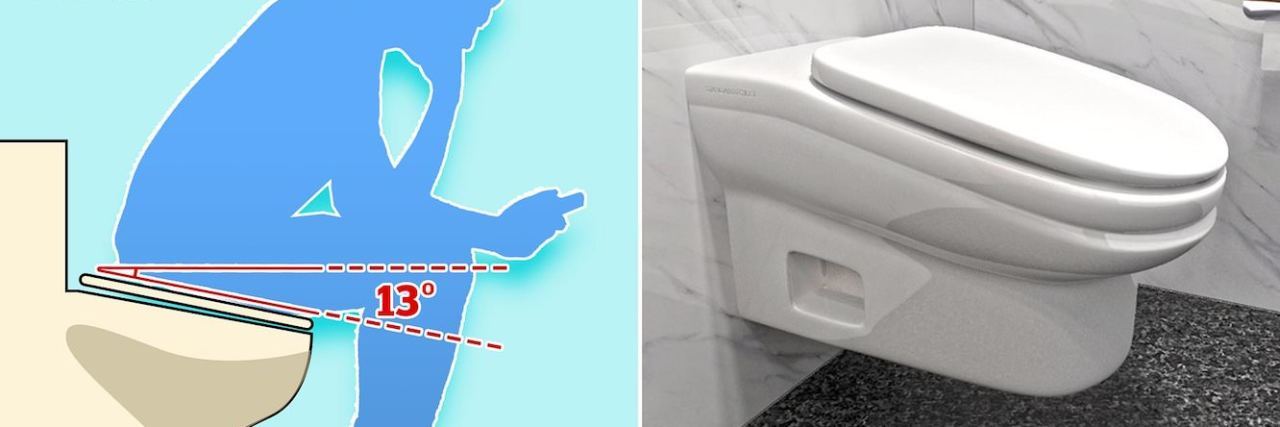In an effort to reduce long wait times to use the toilet, one British inventor created a sloping toilet designed to make doing your duty uncomfortable in just five minutes. People who live with a chronic illness or disability, however, called out the toilet’s ableist aims.
Wired UK reported on what’s being called the “StandardToilet” on Monday. It boasts a seat that slopes at a 13-degree angle (instead of the standard 11 degrees), which designer Mahabir Gill claimed makes it uncomfortable to stay on the toilet for more than five to eight minutes. That angle creates leg strain similar to doing a squat unaided, hence, Gill said, reducing the time people spend in the bathroom.
Gill was inspired to create the StandardToilet because he got tired of waiting in long lines and figured too many people were goofing around on their phones.
“It came from my personal experience where I stopped off at the motorway to go to the loo and realized there’s a huge queue,” Gill told the BBC. “I wondered what people were doing in there, some were coming out with their mobile phones.”
Currently in the prototype stage, Gill already filed a patent and earned an endorsement from the facilities group British Toilet Association. The StandardToilet’s main draw is increased work productivity for employers. A U.K. study published in July suggested workers in London spent an average of 28 minutes on the toilet during work hours. Gill said his toilet can save companies money while moving people through the queue much faster.
“It’s main benefit is to the employers, not the employees,” Gill told Wired. “It saves the employer money.”
Users on social media didn’t waste time shitting on the StandardToilet’s premise.
BREAKING NEWS: Say goodbye to comfort breaks! New downward-tilting toilets are designed to become unbearable to sit on after five minutes. They say the main benefit is to employees in improved employee productivity. pic.twitter.com/lfDbeXJdCX
— Dave Vescio (@DaveVescio) December 17, 2019
This is a straight-up movie villain origin story. Pray his dastardly creation not be unleashed upon the Earth. https://t.co/VOkbVkoJj0 pic.twitter.com/h4fy3y6gDn
— Brian Resnick (@B_resnick) December 17, 2019
Advocates in the chronic illness and disability communities also called out the design as ableist, especially for people with Crohn’s disease, ulcerative colitis and irritable bowel syndrome (IBS), who already have a difficult time accessing restroom facilities. In February, a former Amazon employee with Crohn’s filed a discrimination lawsuit alleging the retail giant fired him because he needed longer bathroom breaks than the company mandated.
This is horrible. Shame on the designers and businesses that might install this toilet. People with chronic and invisible diseases like #crohnsdisease and #colitis already have a difficult time with bathroom access. source: https://t.co/9ih3DknYK9 #spoonies #chroniclife https://t.co/Rdb1H9GNcV
— CreakyJoints.org (@CreakyJoints) December 17, 2019
Making having a poo more uncomfortable targets people living with conditions like #Crohns or #Colitis, who may need additional time to use a toilet. This is discrimination, plain and simple. #NotEveryDisabilityIsVisible #PooTaboo
— Crohn’s & Colitis UK (@CrohnsColitisUK) December 18, 2019
The StandardToilet also makes using the toilet — a basic human right — difficult for those with low muscle tone, arthritis, chronic pain or other disabilities and chronic illnesses.
Was waiting for someone to say this! I have severe joint pain and arthritis throughout the majority of my joints due to a connective tissue disorder. I guess it’s just “screw the people who have a disability of any kind.” Damn..
— ☆~°Kayla Miller°~☆ (@KaylaxRenae) December 18, 2019
Gill claims on his website the StandardToilet has health benefits, like reducing “swollen hemorrhoids and weakening of pelvic muscles” and “reduction in risk of musculoskeletan disorder.” The website also suggests the StandardToliet offers a great benefit to people with disabilities because it will ease “queuing congestion” and therefore reduce “overspill usage of disabled facilities.”
However, as Mighty contributor Dawn Koedyker-Beck pointed out, “innovations” like the StandardToliet won’t fix the fundamental ableist attitudes those with visible and invisible disabilities face when trying to use an accessible bathroom in the first place.
“People who are misinformed, uneducated or simply ill-advised say some downright disrespectful and/or ignorant things towards me and other disabled people and act with poor judgment,” Koedyker-Beck wrote, adding:
Our society has a real status problem with disabled people that manifests in attitudes towards us. Disabled people do have a place in society and should be treated like everyone else. We don’t want pity or unsolicited advice — we want to be treated fairly. Author Yvonne Pierre said it best: ‘When you focus on someone’s disability you’ll overlook their abilities, beauty and uniqueness. Once you learn to accept and love them for who they are, you subconsciously learn to love yourself unconditionally.’
The Mighty reached out to StandardToilet for comment and has yet to hear back.
Article updated Dec. 19, 2019.
Header image via Twitter

